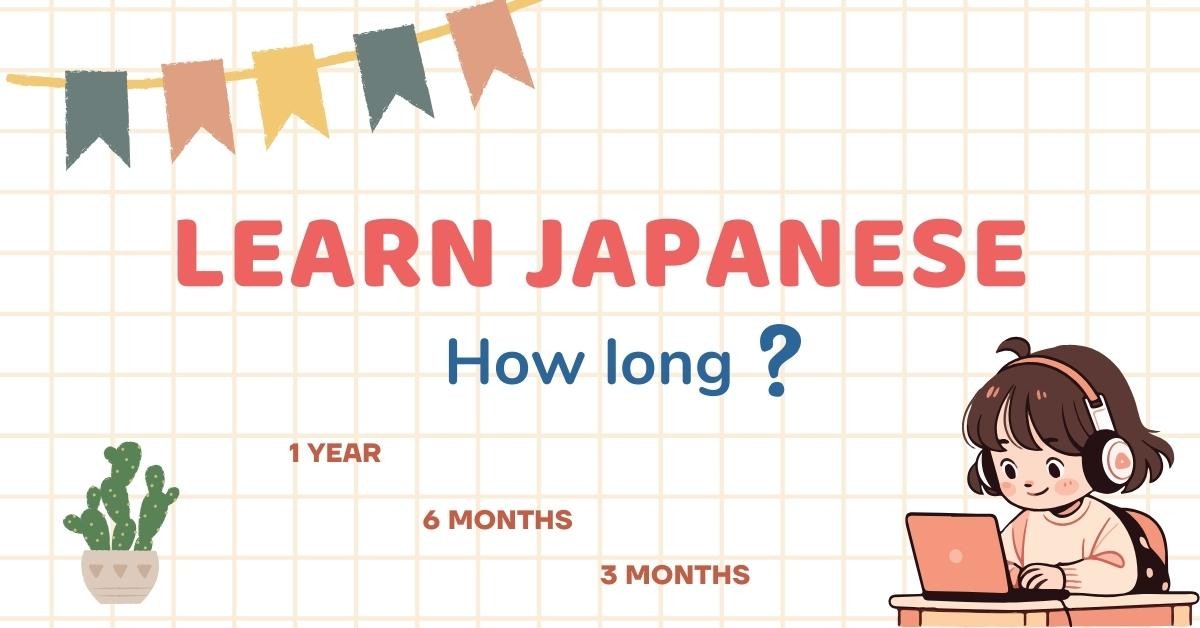- Is Japanese difficult to study?
- Writing System
- Grammar Structure
- Pronunciation
- Cultural Context
- How long does it take to learn Japanese?
- General timeline
- Beginner
- Intermediate
- Advanced
- What affects reaching fluency in a new language?
- Study plan
Curious about how many days to learn Japanese? The time it takes depends on your study methods, dedication, and immersion. While beginners may take a few months, reaching fluency can take years. This guide offers timelines and tips for speeding up your progress and helping you achieve your Japanese learning goals faster.
Is Japanese difficult to study?

Japanese is considered challenging for native English speakers due to its unique grammar, writing system, and pronunciation. However, the difficulty varies depending on individual learning preferences and backgrounds. Here are the key challenges:
Writing System
Unlike many languages, Japanese uses three different writing systems—Hiragana, Katakana, and Kanji. Why does Japan have 3 writing systems? Hiragana and Katakana, phonetic scripts, are relatively easier to learn, but Kanji, which are logographic characters, require memorization of thousands of unique symbols. The need to master these scripts can be overwhelming for beginners.
Grammar Structure
Japanese grammar is quite different from English. It uses a Subject-Object-Verb (SOV) word order rather than the Subject-Verb-Object (SVO) order that English follows. Additionally, Japanese employs particles to indicate grammatical relationships, which can be difficult to master for beginners.
Example:
English: "She reads a book." (SVO)
Japanese: 彼女は本を読みます (Kanojo wa hon o yomimasu - "She book reads.")
Pronunciation
Japanese pronunciation is relatively simple, with clear and consistent vowel sounds. However, pitch accents vary by region, making listening and speaking challenging for non-native speakers.
Example: あめ (ame) can mean "rain" (雨) or "candy" (飴), depending on the pitch accent.
Cultural Context
Japanese is deeply tied to culture, with honorifics and politeness levels influencing communication. Knowing when to use formal or casual speech is essential for effective conversation.
For example, "thank you" is ありがとう (Arigatou) casually, but ありがとうございます (arigatou gozaimasu) in formal settings. Understanding these nuances is crucial for mastering the language.
For a deeper look at why Japanese is considered difficult, check out this article on how hard is Japanese to learn for English speakers.
How long does it take to learn Japanese?
General timeline
The time it takes to learn Japanese varies, but here is a general timeline based on proficiency levels:
- Beginner level: 3-6 months
- Intermediate level: 1-2 years
- Advanced level: 3-5 years
These are average estimates, and the actual time may differ depending on factors like study methods, consistency, and personal aptitude.
You may want to read how hard is learning japanese.
Beginner
As a beginner, your primary focus will be on mastering the two syllabaries—Hiragana and Katakana—and building a basic vocabulary. At this stage, you’ll also begin learning essential grammar rules and common phrases. You’ll likely spend 3 to 6 months learning the basics, which include:
- Understanding and using Hiragana and Katakana fluently
- Learning essential vocabulary for daily conversations
- Familiarity with basic sentence structure
- Recognizing and reading basic Kanji characters
While you won't be able to engage in complex conversations yet, you'll be able to communicate on a basic level, such as introducing yourself, asking simple questions, and understanding basic text.

Intermediate
At the intermediate level, you start focusing on Kanji, more advanced grammar patterns, and enhancing your speaking and listening abilities. You'll begin reading short stories, manga, or beginner-level news articles and will likely understand simple conversations in daily life.
It typically takes 1 to 2 years to reach this stage. By the end of this phase, you should:
- Be able to write and read approximately 300-500 Kanji characters
- Hold more complex conversations about topics like work, hobbies, and travel
- Understand the grammar required to express a variety of thoughts and ideas
- Comprehend intermediate-level written content, such as children’s books or simpler novels
During this period, immersion becomes crucial. This can include traveling to Japan, joining language exchange programs, or regularly consuming Japanese media.
Advanced
The advanced stage is where true fluency begins to take shape. At this level, you can understand almost everything in Japanese, including TV shows, books, and movies, and engage in discussions on more complex topics such as politics, culture, and abstract concepts.
It can take 3 to 5 years to reach an advanced level, depending on the time you dedicate to study. Here are some milestones you can expect:
- Mastery of approximately 1,000-2,000 Kanji characters (necessary for reading newspapers and novels)
- Full understanding of formal and informal speech registers
- The ability to comfortably converse on a wide range of topics
- Fluency in reading and writing formal documents, like emails, reports, or essays
- Understanding native-level content such as news broadcasts, TV shows, and literature
Achieving fluency requires not only classroom learning but also continuous exposure to the language, whether through travel, work, or personal immersion.
What affects reaching fluency in a new language?
Several factors contribute to how quickly you reach fluency in a language. These factors include your study plan, motivation, personality, and access to quality learning resources.
Study plan
A solid study plan is crucial for language learning success. Consistency is key, and it’s best to focus on different aspects of the language:
- Grammar: Focus on understanding sentence structure and grammatical rules.
- Vocabulary: Expand your vocabulary daily, especially words that are useful in everyday situations.
- Kanji: Gradually build your Kanji knowledge, focusing on the most commonly used characters first.
- Listening and Speaking: Incorporate listening and speaking practice regularly to build fluency in real-world conversations.
- Reading and Writing: Dedicate time to reading simple texts and writing regularly, even if it’s just journaling in Japanese.
A structured approach, alongside daily practice, will ensure steady progress and help you avoid frustration.

Level of motivation
Your level of motivation plays a huge role in how fast you can learn Japanese. If you are highly motivated—whether for travel, business, or personal growth—your dedication will help you stay on track.
Set clear, attainable goals, and keep track of your progress. Celebrate milestones, no matter how small, to maintain motivation throughout your learning journey.

Personality and learning traits
People learn in different ways. Some are visual learners, while others might benefit more from listening or hands-on practice. It’s important to understand your learning style to use the most effective methods for you.
For example, if you enjoy visual aids, consider using flashcards or apps. If you’re more of a social learner, find a language partner or join language exchange groups.

Learning resources
The right learning resources can dramatically speed up your progress. Books, apps, podcasts, online courses, and tutors can help you build a strong foundation. Using a variety of resources—such as language exchange apps, immersive media like anime and manga, and language learning platforms like Duolingo or Anki—will keep your study routine engaging and diverse.
For more information on how to find the best resources for learning Japanese, check out this guide on learning Japanese online for free.

In conclusion, the time it takes to answer how many days to learn Japanese varies based on your study habits and goals. With dedication, the right resources, and consistent practice, you can accelerate your learning journey and reach fluency faster. Keep focused, and progress will follow!









